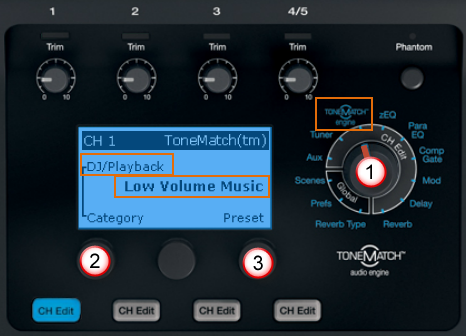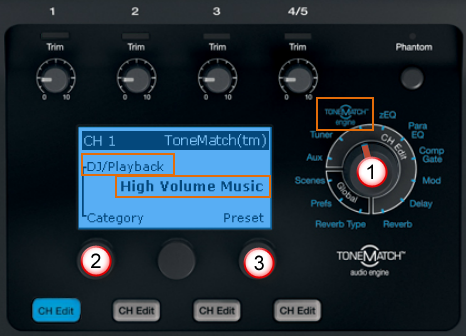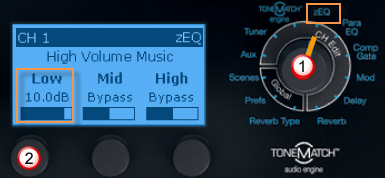I Need More Bass
Contents
|
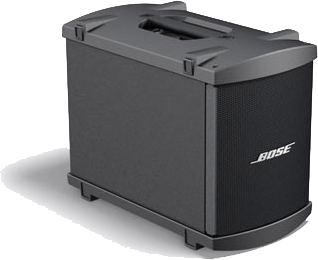
If you want more low end support from your L1®, this article is for you. |
One B1
It sounds too simple, but try turning up the
- zEQ on the T1 ToneMatch Audio Engine.
- Low on the R1 Remote
or
- Experiment with placement of the B1 Bass Module in different parts of the room. See B1 Bass Module Bass Module Positioning below.
These T1® settings can be used in conjunction with all of the other suggestions below.
T1 ToneMatch® Audio Engine Settings
Preset
There are two T1® Presets specifically for DJ/KJ use with Prerecorded Music or more generally, backing tracks.
Category: DJ/Playback
Preset: Low Volume Music
- This is optimized for low volume music. The low bass is boosted to better match the physics/psychoacoustics of our own auditory system.
Category: DJ/Playback
Preset: High Volume Music
- This is optimized for higher volume music. Some of the bass is boosted and some of the upper mids are reduced to have a more natural sound at these higher volumes.
zEQ
Sample setting shown
Two B1s
Adding a second B1 is a great investment as this allows you to fully utilize the amplifier in the Power Stand that is dedicated to Bass.
The Classic / Model I / Model II / Model 1S output for the B1s is
- 125 Watts into 8 ohms (single B1)
- 250 Watts into 4 ohms (two B1s)
Hilmar-at-Bose tells us:
If you have two sound sources that are
- relatively small
- not driven very hard
- you look only at relatively low frequencies
Then you get +6 dB more sound pressure level (SPL) from 2 as compared to one.
Our B1 is a good example of that:
- 2 B1s give 6 dB more than one.
- You gain 3 dB by simply doubling the electrical power (250 Watt for two, 125 Watt for one).
- The other 3 dB is gained by doubling of acoustic volume, cone area and close coupling between the speakers.
To get the same SPL (as 2 B1s) from a single B1 you would actually have to hit it with four times the power (500 Watt).
Source: How much power... discussion in the Bose® Pro Portable PA Community
- System voicing
- Hilmar-at-Bose
- We have carefully voiced the system to have the "best" spectral balance. Ideally, this spectral should not change, no matter how many bass modules are attached. More bass modules simply allow you to play louder and have more headroom. Adding the second B1 will not change the spectral balance but play louder.
- The Power Stand senses how many B1 bass modules are attached (0[1], 1 or 2) and adjusts the internal EQ accordingly. In the case of attaching the second B1 the Power Stand will drop the bass level by about 6 dB so that the overall acoustic output stays the same.
- You can actually notice the change: When you attach (or detach) the second B1, the systems mutes for about a second, adjust its EQ and then comes back again. That's perfectly safe to do while the system is playing.
- Source: Hilmar-at-Bose replies to Single or Double Bass... discussion in the Bose® Pro Portable PA Community
More Than Two B1s with a Power Stand
You can have up to two B1 Bass Modules connected to an L1® Power Stand.
- You can add two more B1 Bass Modules powered by the PackLite® power amplifier Model A1
- You can purchase the Packlite® and two B1 Bass Modules as a PackLite® Extended Bass Package
- You can add as many PackLite® Extended Bass Packages as you like to a single L1®, although it is unlikely you would go beyond four B1 Bass Modules except for live music in a very large venue.
- If you have an L1 Classic you can use that to drive up to six B1 Bass Modules. For details see: Classic Extended Bass Package
B2 Bass Module
September 2012, Bose introduced the B2 bass module.
If you need more bass, you owe it to yourself to check out the B2 Bass Module.
B1 Bass Module Bass Module Positioning
- Although originally written about the Bose B1, this article is applicable to all Bose bass modules and subwoofers (B1, B2, Sub1, Sub2).
It Depends
- Where and how is the best way to place the Bass Module or Sub; single, double, and quad?
The short but annoying answer is of course, "it depends" and the slightly longer, but still unsatisfying answer is, "results will vary from case to case in ways that even the best acousticians can't anticipate." But you'll often find recommendations on the web or even in technical journals by folks who have only considered a subset of the factors that contribute. The authors may not know about the other factors or, more likely, they may be hoping that those other factors can be ignored. The temptation to extrapolate beyond the part that one grasps is almost irresistible. Hope springs eternal. One wants to give a satisfying answer, even when it is out of reach.
This is not as hopeless as it sounds, because there is an important distinction between "what is best?", which we cannot answer, and "what do you recommend that I do?" which we should and can answer. We can also say some things about "what should I NOT do?" Here I will give you a random smattering of such recommendations and hope that they will suffice until I can give a fully organized wiki entry. It's a pretty long post, but I hope it will address most of the questions that have arisen. (It takes more time to make a shorter post. Smile ) If not, ask more questions and that will help me make the wiki entry more complete. Chris
Orientation, aiming and obstruction
Sound comes through the bass module grille only and then spreads out the same amount in all directions from that surface. So box orientation doesn't matter to the bass module sound. Sonically the bass module can rest on any one of its four sides and nothing will change. (Of course, for stacking, you want the "wide side down" in order to engage the nubs on the next bass module.) Once you pick a side to rest it on, you can aim the bass module in any direction you want, forward, sideways, even firing backward toward a rear wall. If you hear a change, it is because you've moved the grille relative to other bass modules or relative to boundaries. Don't shove the grille into a wall or into a big obstacle, because then the sound can't get out; leave at least 6 inches (15 cm) of space in front of the grille. The side of the box itself can be right against a wall, so long as the grille is not obstructed. We often start out placing our bass modules on the floor, sideways against the rear wall, so that the first reflections from the floor and rear wall will not change the tonal balance in the bass. (Room modes will change the tonal balance anyway, but at least we eliminate one source of variability this way.)
Arranging groups of Bass Modules or Subs that play the same signal
When multiple sources playing the same signal are spaced apart, they make an "array" which means that the tonal balance they radiate can be different in different directions. If you understand array theory, you can make this work for you, but in our case, it is safest to keep the spacings as small as we can, so that the array radiates the same in all directions. When we keep the spacing tight, multiple B1s will behave just like single B1s, only louder. What matters here are the spacings of the grilles, not the cabinets, because the grilles are where the sound comes from. The more specific suggestions that follow below rely partly on my own understanding of the theory and partly on consultation with Hilmar, who has both theory and a lot of experience to guide him.
Two Bass Modules or Subs
In any arrangement where the grilles fit completely within a 30-inch (75 cm) diameter sphere, your two bass modules will act like a single one, only louder. Note that spacing two bass units on the floor with the L1 Classic or L1 Model I or L1 Pro32 Power Stand between them does not meet this criterion. That arrangement would reduce the mid-bass that radiates to the left and right sides.
For two bass modules or Subs, we prefer to stack them on their wide sides, mostly because this takes the minimum floor space. But you can place them side by side or even face to face, leaving 12 inches (30 cm) between grilles (because this is 6 inches (15 cm) in front of each bass module or Sub). Sonically, it doesn't matter which wide side is up and the two don't have to have the same side up. Sonically, you can even have one bass module or Sub on its wide side and one on its handle side, although that looks funny. In fact, for two bass modules or Subs, "looking good" places more restrictions on what you do than "sounding good."
Four B1s (applies to Legacy L1 not L1 Pro series)
For 4 B1s, we are most likely to stack all 4 on their wide sides, but sometimes we make two stacks of two, side by side. The stack of four takes up the least floor space, but it radiates a little less mid-bass upwards, which has not been a problem and might be beneficial. We don't lay all four in a line on the floor on their wide sides, since we expect this to weaken the midbass that travels left and right toward other band members or audience at the sides. You could probably lay all four in a line if you rest them on their handle sides, so that they make a short line. If you use the 2x2, keep the two stacks adjacent to avoid possibly weakening the mid-bass to the sides.
Locating the Group of Bass Modules
Where to locate the group: If the group of B1s is far from its L1, the lows will come from one place and the highs from another and this is harder for everyone to hear clearly. More than about 5 feet (1.3 m) of separation is probably beginning to compromise your spatial quality. It's best if you can keep the B1s adjacent to or within a foot (30 cm) of the PS1. Since our preferred arrangements are stacks of 2 or 4 B1s, we also like to aim those stacks sideways and place them against the rear wall if we can, because this minimizes unwanted array effects with the first reflections. But we don't hesitate to aim the stacks forward when the best appearance is more important. In this case, we keep the B1s as close to the back wall as the connectors allow, but being careful not to stress the cables by bending them too sharply against the wall. Although we prefer to keep the B1s as close to the rear wall as we can, there are times when this is just not an option. In such cases, we try to get 7 feet (2.1 m) or more from a rear wall as a second choice because, in the 2-7 foot (0.6-2.1 m) range, the reflection from the rear wall tends to reduce some of the bass frequency range in the audience (an interference effect). Sometimes we have no choice but to place B1s in that 2-7 foot (0.6-2.1 m) range and we just live with the minor reduction in bass, perhaps compensating with a bass tone control boost.
Other variations: It's okay to raise the B1s on short risers if you like, but I don't know of any reason why this would always sound better or worse, just different. Floors and walls are not perfect reflectors of bass[2], but I have no different recommendations to make due to this source of variation.
It Depends
Although the above suggestions describe our default arrangements, they don't always yield good-sounding results. The factor that we can't really control or understand easily is the room. Rooms often cause very uneven distribution of bass and there is no universal method of cure. Sometimes a different speaker placement seems to help, but what helps for one listener usually makes it worse elsewhere. It's easy to fool yourself and it's easy to fuss endlessly without finding a good solution. We try not to fall into that trap. If one or two alternatives don't cure the problem, we give up and move on.
There are only a few techniques that we think are likely to help. First, if there is too much bass, we might try to fix that with a tone control reduction before moving anything, since, if it works, we will have higher maximum bass output available to us (because the bass amp is working less hard to give the right amount of bass). If a bass control adjustment doesn't straighten out the problem we hear, we might move the stack closer to or farther from the nearest corner. Closer sometimes increases bass while farther sometimes reduces it. (That's the simplified theory, anyway.) But proceed with care: the change the musicians hear will probably be different from the change in the audience. Make sure you know who you are trying to improve the sound for. The last thing we might try is a different arrangement, say switching from a stack of 4 to 2x2. If these few alternatives don't give a clear improvement (and they usually don't), we think it's time to shrug our shoulders and get on with the show.
Who Wins?
Ultimately, we have to be willing to accept that often the room will "win" and we won't get the ideal bass response. This will be true for any bass system, not just specifically for the B1. There is no point in worrying about this--we do what little we can to avoid the worst and then concentrate on giving a good performance. If we do that, the L1 will make sure people enjoy the sound, even when the bass isn't all that we'd like it to be.
More Information
File:The-Subwoofer-Power-Alley-1.pdf
Bass Outdoors
Originally posted by Chris-at-Bose on the Bose Musicians Forum[3]
L1® versus B1 Bass Module Fall Off Over Distance
Hi folks, As many of you know first-hand, nearby direct sound from the L1 falls off with distance more slowly than most other speakers, including all bass speakers, and including B1 Bass Modules. We rarely notice this difference indoors, because room modes in the bass impose large changes from place to place that dominate over the different rates of fall-off of the direct sound waves from the L1 and B1 Bass Module.
But outdoors, there is nothing to prevent us from noticing that the bass falls off more rapidly with distance than the L1 's sound does. This will happen no matter how many B1 Bass Modules we have, no matter what EQ or presets we use, and it will also happen if we use other subs, no matter how big they are. The only ways to fully prevent it would be to either give up the slow fall-off of the L1 :( or make a line array of bass speakers at least 15 feet tall (wow!), but, aside from the expense, such a thing would be extremely dangerous. :eek: So we have to find a way to optimize the effect because we can't make it go away.
Before I explain how to do that, I want to describe the effect in a different way that makes the solution more clear. Since the bass and mid-highs are falling at different rates with distance, there can be only one distance where the balance between bass and mid-highs is "perfect". To my ears, the L1 and B1 achieve this balance point outdoors somewhere in the 10-20 foot range, call it 15 feet. But how much closer or farther must I go to hear a small change in the balance? Human hearing is not very sensitive to small changes in bass level, so 3dB counts as a small change in this frequency region. If I go to either half the distance (7.5 feet) or double the distance (30 feet) I hear a small change of 3dB in the bass balance compared to the ideal. That's because the L1 changes by 3 dB per doubling or halving of distance, while the B1 changes 6 dB, so the difference between them changes 3 dB either way. So there is a large region of distance where the bass is very close to the ideal level and that region covers about a 4 to 1 distance range, in this case about 7.5 to 30 feet.
Now what if I boost the level of the bass by 3dB with a tone control? (A tone control isn't perfect compensation for this effect at all frequencies, but it's not bad.) Now the point of "perfect balance" moves out from about 15 feet to about 30 feet, and the range over which the balance is close to ideal becomes about 15-60 feet, still about a 4 to 1 range. If I boost the bass control even more, the range moves out further, but keeps the 4 to 1 ratio. So now you see how to optimize this effect. Simply apply modest bass boost until the tonal balance is not quite thin at the largest distance you want to cover. Then the balance will be very close to correct from that distance to about 1/4 of that distance. Inside that range, the bass will be modestly stronger than normal, but we all tolerate a little extra bass better than we tolerate too little. :)
There is one thing to keep in mind when applying this outdoor optimization. You are asking for more bass from your B1s and they may not have more to give at the level you want to deliver. If you try to eliminate the thinness with a bass control and it doesn't increase the bass you hear, then your B1s are already giving all they've got and you will need more B1s (for this job) to get the bass control to have any effect. (Remember that more B1s will not replace the need to use the bass tone control here, because the PS1 keeps the tonal balance the same as you add more B1s.)
But before you invest in more B1s, make sure you are getting all the bass you are entitled to from the ones you have. For stereo music playback, you can get a little more bass by stacking your left and right B1s tight together. Outdoors, if there is a hard wall nearby, you can get a good deal more bass by placing all the B1s right at the wall. If you can't get right to the wall, then keep the B1s at least 7 feet away from the wall. If you place B1s outdoors anywhere from 2 to 7 feet from a hard wall, you will get a big hole in the bass response--bass notes will be very weak at some pitches while other pitches will be okay. The reduction in bass in that case will be significant. Try to avoid such placement if you can.
Getting the Most from the B1s
Overall, outdoor settings demand more from your sound system in the bass than indoor settings, because outdoors there is no bass reinforcement from a room. Also, people are often farther away outdoors. Both factors lead to your often needing more B1s outdoors than indoors. Please try these other ideas before getting out your wallet.
Hope this is helpful.
Chris
- ↑ not applicable to Model II or Model 1S - both must use at least one Bass module.
- ↑ Floors and walls are not perfect reflectors of bass - see: B1 Bass Module / Walls
- ↑ Chris-at-Bose responds to First soundcheck outdoors
Longer Cables for B1s
The Bose B1/B2 requires a NL4 connector with all 4 pins connected (that's why we call it 4-wire cable). Unfortunately, the Speakon connector comes in three different flavors, NL2 (2-pins), NL4 (4 pins), and NL8 (8-pins). Most salespeople are not aware of the differences.
A good source for the correct cables is
Audiopile.net NL413GA | NL4 Speakon equipped 13/4 Speaker Cable
- Note
- If you have an L1 Model 1S or L1 Model II - do NOT add a 10k resistor to the cable. That's only required with an L1® Model I or L1® Classic and ONLY if you are using a B2. It is not required with B1 bass modules.
Consider getting 90-degree ends like this:
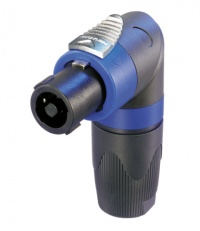
— Click image for details —
If you call Mark and tell him you want the cable for the Bose B1, you will get one that is made to our specifications. You can also any custom length cable at a very reasonable price.
- Hilmar-at-Bose[1]
External Subwoofers
Passive (unpowered) Loudspeakers
Using loudspeakers other than the B1 Bass Module with any of the L1® systems is not supported. However you can safely try your own external subs if the impedance is no lower then 4 ohms (typically a single 4 ohm loudspeaker or two 8 ohm loudspeakers in parallel). The output from the Power Stand is 250 watts RMS into 4 ohms.
L1® Classic and L1® Model I
For the sake of those attaching third party passive speakers (an unsupported application).
Output if no B1 Bass Modules detected
- 40-180 Hz Bandpass (that is: NO B1 EQ)
If one or two B1 Bass Modules detected (or resistors used across NL4 2+ / 2- pins to emulate detection)
- 40-180 Hz with different EQ curves. For details on how to do this see: Activating B1 EQ Curves
For more details about the Power Stand outputs see: PS1 Power Stand / Bass Line Out
L1® Model II
For the sake of those attaching third party passive speakers (an unsupported application).
Output if no B1 Bass Modules detected
- 40-200 Hz Bandpass (that is: NO B1 EQ)
If one or two B1 Bass Modules detected (or resistors used across NL4 2+ / 2- pins to emulate detection)
- 40-200 Hz with different EQ curves. For details on how to do this see: Activating B1 EQ Curves
For more details about the Power Stand outputs see: L1® Model II Power Stand / Bass Line Out
Active (powered) Loudspeakers
Using powered loudspeakers with any of the L1® systems is not supported.
PackLite® power amplifier Model A1
The PackLite® power amplifier Model A1 is part the L1® System. It can be used to power up to two B1 Bass Modules. This is connected to the Power Stand Bass Line Out.
Third Party (non-Bose®) Systems
If you want to use a powered loudspeaker system, you can use the Power Stand Bass Line Out as the signal source. Here are notes specific to the L1® you are using.
You will probably use an powered loudspeaker in the same way as you would connect an PackLite® amp.
Please see PackLite® power amplifier Model A1 for extensive notes that include ideas that can be applied to other systems.
Ongoing discussion
I need more bass article - discussion




